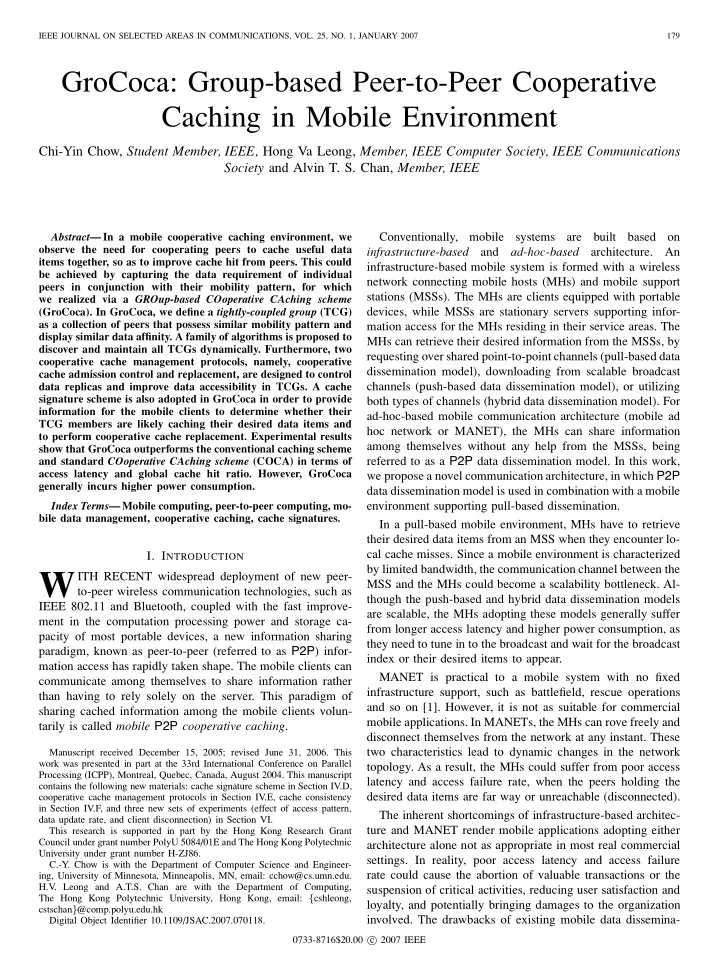

IEEE JOURNAL ON SELECTED AREAS IN COMMUNICATIONS, VOL. 25, NO. 1, JANUARY 2007 179 GroCoca: Group-based Peer-to-Peer Cooperative Caching in Mobile Environment Chi-Yin Chow, Student Member, IEEE, Hong Va Leong, Member, IEEE Computer Society, IEEE Communications Society and Alvin T. S. Chan, Member, IEEE Conventionally, mobile systems are built based on Abstract — In a mobile cooperative caching environment, we observe the need for cooperating peers to cache useful data infrastructure-based and ad-hoc-based architecture. An items together, so as to improve cache hit from peers. This could infrastructure-based mobile system is formed with a wireless be achieved by capturing the data requirement of individual network connecting mobile hosts (MHs) and mobile support peers in conjunction with their mobility pattern, for which stations (MSSs). The MHs are clients equipped with portable we realized via a GROup-based COoperative CAching scheme (GroCoca). In GroCoca, we define a tightly-coupled group (TCG) devices, while MSSs are stationary servers supporting infor- as a collection of peers that possess similar mobility pattern and mation access for the MHs residing in their service areas. The display similar data affinity. A family of algorithms is proposed to MHs can retrieve their desired information from the MSSs, by discover and maintain all TCGs dynamically. Furthermore, two requesting over shared point-to-point channels (pull-based data cooperative cache management protocols, namely, cooperative dissemination model), downloading from scalable broadcast cache admission control and replacement, are designed to control channels (push-based data dissemination model), or utilizing data replicas and improve data accessibility in TCGs. A cache signature scheme is also adopted in GroCoca in order to provide both types of channels (hybrid data dissemination model). For information for the mobile clients to determine whether their ad-hoc-based mobile communication architecture (mobile ad TCG members are likely caching their desired data items and hoc network or MANET), the MHs can share information to perform cooperative cache replacement. Experimental results among themselves without any help from the MSSs, being show that GroCoca outperforms the conventional caching scheme referred to as a P2P data dissemination model. In this work, and standard COoperative CAching scheme (COCA) in terms of access latency and global cache hit ratio. However, GroCoca we propose a novel communication architecture, in which P2P generally incurs higher power consumption. data dissemination model is used in combination with a mobile environment supporting pull-based dissemination. Index Terms — Mobile computing, peer-to-peer computing, mo- bile data management, cooperative caching, cache signatures. In a pull-based mobile environment, MHs have to retrieve their desired data items from an MSS when they encounter lo- cal cache misses. Since a mobile environment is characterized I. I NTRODUCTION by limited bandwidth, the communication channel between the W ITH RECENT widespread deployment of new peer- MSS and the MHs could become a scalability bottleneck. Al- to-peer wireless communication technologies, such as though the push-based and hybrid data dissemination models IEEE 802.11 and Bluetooth, coupled with the fast improve- are scalable, the MHs adopting these models generally suffer ment in the computation processing power and storage ca- from longer access latency and higher power consumption, as pacity of most portable devices, a new information sharing they need to tune in to the broadcast and wait for the broadcast paradigm, known as peer-to-peer (referred to as P2P ) infor- index or their desired items to appear. mation access has rapidly taken shape. The mobile clients can MANET is practical to a mobile system with no fixed communicate among themselves to share information rather infrastructure support, such as battlefield, rescue operations than having to rely solely on the server. This paradigm of and so on [1]. However, it is not as suitable for commercial sharing cached information among the mobile clients volun- mobile applications. In MANETs, the MHs can rove freely and tarily is called mobile P2P cooperative caching . disconnect themselves from the network at any instant. These two characteristics lead to dynamic changes in the network Manuscript received December 15, 2005; revised June 31, 2006. This work was presented in part at the 33rd International Conference on Parallel topology. As a result, the MHs could suffer from poor access Processing (ICPP), Montreal, Quebec, Canada, August 2004. This manuscript latency and access failure rate, when the peers holding the contains the following new materials: cache signature scheme in Section IV.D, desired data items are far way or unreachable (disconnected). cooperative cache management protocols in Section IV.E, cache consistency in Section IV.F, and three new sets of experiments (effect of access pattern, The inherent shortcomings of infrastructure-based architec- data update rate, and client disconnection) in Section VI. ture and MANET render mobile applications adopting either This research is supported in part by the Hong Kong Research Grant Council under grant number PolyU 5084/01E and The Hong Kong Polytechnic architecture alone not as appropriate in most real commercial University under grant number H-ZJ86. settings. In reality, poor access latency and access failure C.-Y. Chow is with the Department of Computer Science and Engineer- rate could cause the abortion of valuable transactions or the ing, University of Minnesota, Minneapolis, MN, email: cchow@cs.umn.edu. H.V. Leong and A.T.S. Chan are with the Department of Computing, suspension of critical activities, reducing user satisfaction and The Hong Kong Polytechnic University, Hong Kong, email: { cshleong, loyalty, and potentially bringing damages to the organization cstschan } @comp.polyu.edu.hk involved. The drawbacks of existing mobile data dissemina- Digital Object Identifier 10.1109/JSAC.2007.070118. 0733-8716$20.00 c � 2007 IEEE
Recommend
More recommend